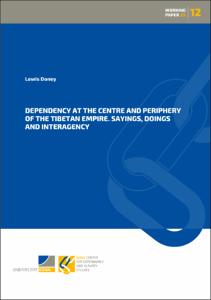Doney, Lewis: Dependency at the Centre and Periphery of the Tibetan Empire : Sayings, Doings and Interagency. Bonn: Bonn Center for Dependency and Slavery Studies, 2023. In: BCDSS Working Papers, 12.
Online-Ausgabe in bonndoc: https://doi.org/10.48565/bonndoc-127
Online-Ausgabe in bonndoc: https://doi.org/10.48565/bonndoc-127
@techreport{handle:20.500.11811/10919,
doi: https://doi.org/10.48565/bonndoc-127,
author = {{Lewis Doney}},
title = {Dependency at the Centre and Periphery of the Tibetan Empire : Sayings, Doings and Interagency},
publisher = {Bonn Center for Dependency and Slavery Studies},
year = 2023,
month = jun,
series = {BCDSS Working Papers},
volume = 12,
note = {This paper presents a microhistory of ninth-century asymmetrical social relations in the centre and on the periphery of the Tibetan empire (ca. 600–850 CE), as well as relations between the periphery and the centre. During the reign of the Yar lung dynasty’s Emperor Khri Srong lde brtsan (r. 756–ca. 800), official documents such as inscriptions represent him as a beneficent ruler of loyal ministers from elite families and as establishing Buddhism for the benefit of his rather non-descript but grateful subjects. The analysis of these rhetorical “sayings” then gives way to describing the “doings” in Dunhuang on the periphery of that empire, inhabited by mostly ethnic Chinese people who both perpetuated and worked within systems of asymmetrical dependency. Eighth- and ninth-century Tibetan emperors gradually introduced new rules for the Tibetan government of both monastic and lay organisations of Buddhists there, and they also employed many of the monks and laity as scribes to copy Buddhist works for the spiritual benefit of the rulers. Works found at the beginning of the twentieth century at the Mogao cave complex near Dunhuang, walled up in Mogao Cave 17 or the so-called “library cave,” offer unparalleled access to their “doings,” the relation of scribes with each other, with sutra editors, and with Tibetan imperial power right up to the emperors themselves. They thus fill out our image of the “interagency” between Tibetan subjects and their asymmetrical relations to the Tibetan empire—while problematizing the emperors’ self representational “sayings” in, inter alia, the imperial inscriptions.},
url = {https://hdl.handle.net/20.500.11811/10919}
}
doi: https://doi.org/10.48565/bonndoc-127,
author = {{Lewis Doney}},
title = {Dependency at the Centre and Periphery of the Tibetan Empire : Sayings, Doings and Interagency},
publisher = {Bonn Center for Dependency and Slavery Studies},
year = 2023,
month = jun,
series = {BCDSS Working Papers},
volume = 12,
note = {This paper presents a microhistory of ninth-century asymmetrical social relations in the centre and on the periphery of the Tibetan empire (ca. 600–850 CE), as well as relations between the periphery and the centre. During the reign of the Yar lung dynasty’s Emperor Khri Srong lde brtsan (r. 756–ca. 800), official documents such as inscriptions represent him as a beneficent ruler of loyal ministers from elite families and as establishing Buddhism for the benefit of his rather non-descript but grateful subjects. The analysis of these rhetorical “sayings” then gives way to describing the “doings” in Dunhuang on the periphery of that empire, inhabited by mostly ethnic Chinese people who both perpetuated and worked within systems of asymmetrical dependency. Eighth- and ninth-century Tibetan emperors gradually introduced new rules for the Tibetan government of both monastic and lay organisations of Buddhists there, and they also employed many of the monks and laity as scribes to copy Buddhist works for the spiritual benefit of the rulers. Works found at the beginning of the twentieth century at the Mogao cave complex near Dunhuang, walled up in Mogao Cave 17 or the so-called “library cave,” offer unparalleled access to their “doings,” the relation of scribes with each other, with sutra editors, and with Tibetan imperial power right up to the emperors themselves. They thus fill out our image of the “interagency” between Tibetan subjects and their asymmetrical relations to the Tibetan empire—while problematizing the emperors’ self representational “sayings” in, inter alia, the imperial inscriptions.},
url = {https://hdl.handle.net/20.500.11811/10919}
}






